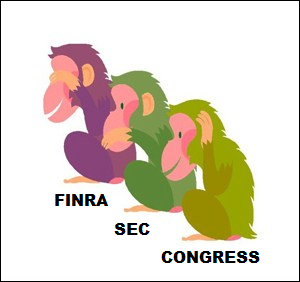Courtesy of Pam Martens
 On Monday, February 5 and again on Thursday, February 8, the Dow Jones Industrial Average closed the day with more than 1,000-point losses. We decided it might be instructive to see what JPMorgan’s Dark Pools were up to that week now that the three-week old data has been released by the self-regulator FINRA. We’ll get to that shortly, but first some necessary background.
On Monday, February 5 and again on Thursday, February 8, the Dow Jones Industrial Average closed the day with more than 1,000-point losses. We decided it might be instructive to see what JPMorgan’s Dark Pools were up to that week now that the three-week old data has been released by the self-regulator FINRA. We’ll get to that shortly, but first some necessary background.
Dark Pools are effectively unregulated stock exchanges that operate in darkness inside Wall Street’s largest firms. If you have been following the past decade of criminal felony counts for colluding in market rigging and multi-billion dollar fines for abusing the public against these same firms, you might be forgiven for thinking that Federal regulators have lost their minds to allow these same firms to operate Dark Pools. But it’s actually worse than it first appears: not only are JPMorgan Chase, Citigroup, Goldman Sachs and other Wall Street banks trading stocks in darkness, but they’re being allowed to trade the shares of their own bank in these Dark Pools, as well as that of their peer banks.
And, it’s even worse than all that. In addition to trading the bank stocks of their competitor Wall Street banks with whom they have major derivative exposure and engage in underwriting syndicates, they are also allowed to issue buy, sell and hold stock research reports on their competitor banks, despite all of the major Wall Street firms being charged with fraudulent or deceptive research practices by the Securities and Exchange Commission in 2003.
To give the weak appearance that the public has some insight into what’s going on in these Dark Pools, FINRA – the deeply conflicted self-regulator – began reporting three-week old trading data to the public on June 2, 2014. But the data is lumped together for the entire week. It doesn’t show any individual day’s data; it doesn’t show what time the trades were made. So, for example, if an investigative reporter or scholar wanted to see if trades were bunched at the open or close of trading in order to manipulate the markets, that’s impossible to do. If public investigators wanted to see if a Dark Pool did heavy buying in its own stock during a period of the trading day when its share price was plunging, that’s also impossible to do.
After the stock market collapse in 1929, the U.S. Senate Banking Committee conducted an extensive investigation over three years into the trading practices on Wall Street. (No such intensive trading investigation was conducted after the 2008 Wall Street crash.) Much of the Senate investigations of the early 1930s focused on the dirty dealings of “Pools,” now reincarnated as Dark Pools. The Senate report found the following:
“A pool, according to stock exchange officials, is an agreement between several people, usually more than three, to actively trade in a single security. The investigation has shown that the purpose of a pool generally is to raise the price of a security by concerted activity on the part of the pool members, and thereby to enable them to unload their holdings at a profit upon the public attracted by the activity or by information disseminated about the stock. Pool operations for such a purpose are incompatible with the maintenance of a free and uncontrolled market.”
…



